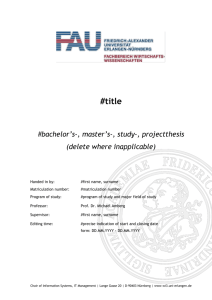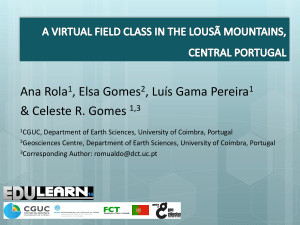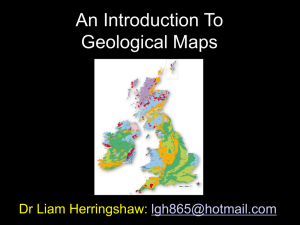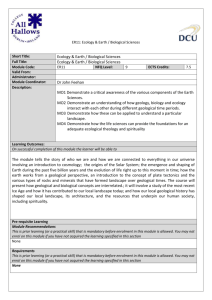Minutes - Preparation for the comparison of the - Indico
advertisement
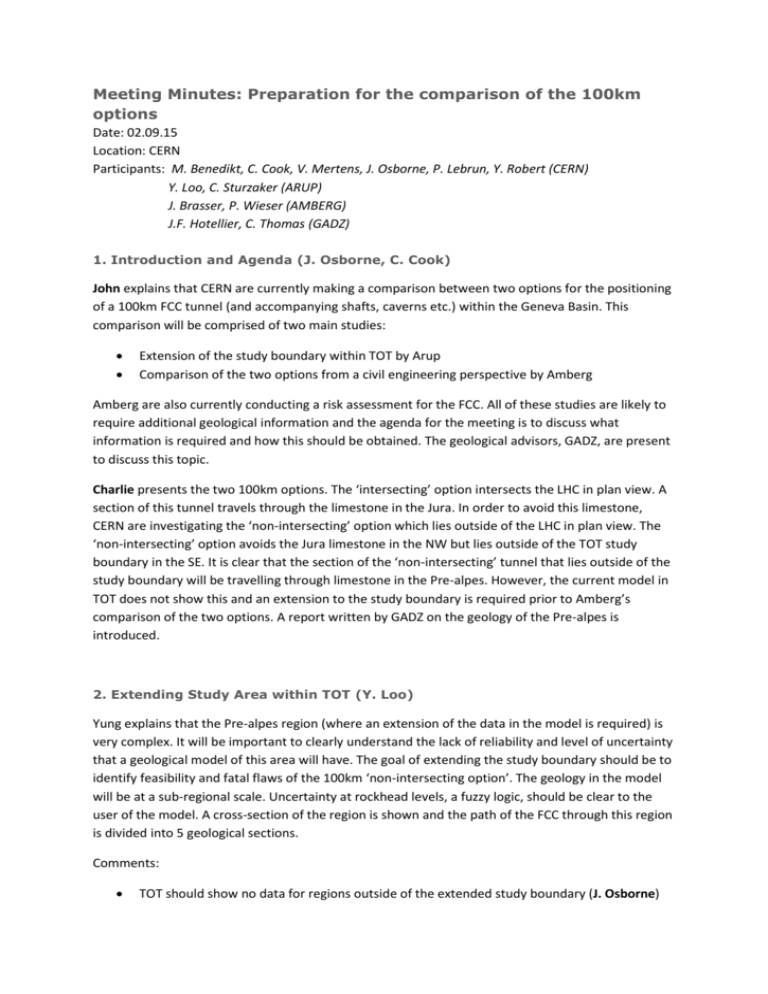
Meeting Minutes: Preparation for the comparison of the 100km options Date: 02.09.15 Location: CERN Participants: M. Benedikt, C. Cook, V. Mertens, J. Osborne, P. Lebrun, Y. Robert (CERN) Y. Loo, C. Sturzaker (ARUP) J. Brasser, P. Wieser (AMBERG) J.F. Hotellier, C. Thomas (GADZ) 1. Introduction and Agenda (J. Osborne, C. Cook) John explains that CERN are currently making a comparison between two options for the positioning of a 100km FCC tunnel (and accompanying shafts, caverns etc.) within the Geneva Basin. This comparison will be comprised of two main studies: Extension of the study boundary within TOT by Arup Comparison of the two options from a civil engineering perspective by Amberg Amberg are also currently conducting a risk assessment for the FCC. All of these studies are likely to require additional geological information and the agenda for the meeting is to discuss what information is required and how this should be obtained. The geological advisors, GADZ, are present to discuss this topic. Charlie presents the two 100km options. The ‘intersecting’ option intersects the LHC in plan view. A section of this tunnel travels through the limestone in the Jura. In order to avoid this limestone, CERN are investigating the ‘non-intersecting’ option which lies outside of the LHC in plan view. The ‘non-intersecting’ option avoids the Jura limestone in the NW but lies outside of the TOT study boundary in the SE. It is clear that the section of the ‘non-intersecting’ tunnel that lies outside of the study boundary will be travelling through limestone in the Pre-alpes. However, the current model in TOT does not show this and an extension to the study boundary is required prior to Amberg’s comparison of the two options. A report written by GADZ on the geology of the Pre-alpes is introduced. 2. Extending Study Area within TOT (Y. Loo) Yung explains that the Pre-alpes region (where an extension of the data in the model is required) is very complex. It will be important to clearly understand the lack of reliability and level of uncertainty that a geological model of this area will have. The goal of extending the study boundary should be to identify feasibility and fatal flaws of the 100km ‘non-intersecting option’. The geology in the model will be at a sub-regional scale. Uncertainty at rockhead levels, a fuzzy logic, should be clear to the user of the model. A cross-section of the region is shown and the path of the FCC through this region is divided into 5 geological sections. Comments: TOT should show no data for regions outside of the extended study boundary (J. Osborne) The geology in this region of the Pre-alpes is particularly difficult to map due to its complexity. Any drawing of this region will merely be an interpretation of what the geology ‘might’ be like (J.F. Hotellier). Amberg understands that there is a high level of uncertainty inherent in geological interpretations with very limited available data (J. Brasser) P. Lebrun asks GADZ about the feasibility of conducting seismic sounding in the region J.F. Hotellier replies that seismic soundings are very unreliable and difficult to conduct in mountainous regions. J. Brasser suggests that any cross-sections of the geology in this region that GADZ can provide will be useful for their studies Y. Loo suggests that once the study boundary has been extended, cross-sections from GADZ should be used in conjunction with outputs from the model. 3. Overview of Amberg studies and geological investigation methods (J. Brasser) Johann Peter presents the current understanding of the civil engineering (what we know). The risk assessment study is then presented. The risk assessment is divided by construction elements (tunnels, shafts and caverns) and geology. Hazards, mitigation methods and level of risk for each division are detailed. A proposal for the next steps is presented, this includes; longitudinal profiles for each zone (as was provided for the Mandallaz), define geotechnical properties of soil/rock of each zone, verify construction methods for each of the 36 construction elements (12 shafts, 12 tunnel sections and 12 caverns). Longitudinal profiles would provide useful geological information for both the risk assessment and 100km options comparison study. Comments: The unit weights developed in the previous study may underestimate the risks under discussion of tunnelling through the Jura limestone (P. Lebrun) The Amberg metrics helped to begin quantifying the various options studied before focussing on 100kms, but now a more detailed, section by section, study should be performed by Amberg to compare the two 100km options and the metrics will not be used (C. Cook) 4. Geology in the Pre-alpes and geological investigation methods (C. Thomas) Cyril presents the data currently available in the Pre-alpes region. The best source of data is the Annecy-Bonneville geological map. Some boreholes have been drilled for geothermal studies but these are short and the data is unreliable. It is recommended that Arup and GADZ should not attempt to differentiate between the different types of limestone in the Pre-alpes region. The model and longitudinal sections should aim to differentiate between limestone and molasse only. Cyril presents the geological conditions of the FCC section by section. It is noted that the quality of the molasse is uncertain in the l’Arve valley region, there may be issues with water at depth in the Mandallaz limestone and also risk of hitting water in the Jura. The geological complexity and difficulty of tunnelling through the Pre-alpes limestone is again emphasised. Geological investigation methods are presented. These are seismic lines or boreholes and the execution, applications and cost of each are described. Comments: Longitudinal sections of this region will be very helpful for Amberg (J. Brasser) The extension of the study boundary within TOT should begin once longitudinal sections are received from GADZ (Y. Loo) A dedicated GIS site on CERN’s computer infrastructure is being created by Youri. This will help GADZ, Amberg and Arup to view the locations of the FCC traces in more detail. Satellite imagery of the region and a Digital Elevation Model will be included in the map (Y. Robert). The timeframe for the preparation of longitudinal cuts by GADZ should be the end of September (J. Osborne) Actions (for completion in September 2015) Complete dedicated GIS webpage for FCC at CERN – CERN Prepare longitudinal sections for use by Amberg and Arup – GADZ Delete data outside of extended study boundary in TOT – ARUP Prepare TOT in preparation for the extension of study boundary once information from GADZ is received – ARUP Await receipt of longitudinal sections from GADZ and extension of the study boundary in TOT before commencement of the ‘comparison of the 100km options’ study - AMBERG Long term actions Be ready to present initial results of the comparison between the two 100km FCC options by the end of 2015



